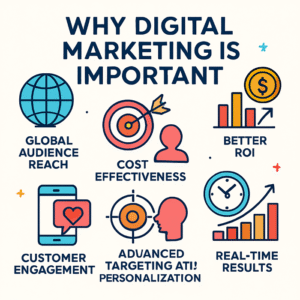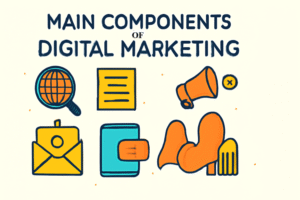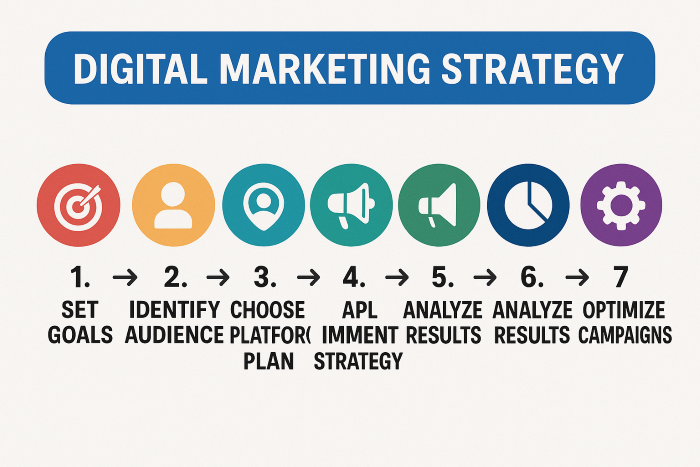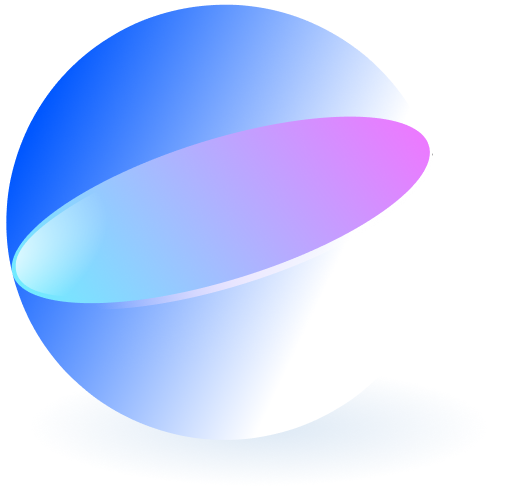Digital Marketing Strategies, Tips, and Guides to Grow Your Business Online

what is Digital marketing ?
Digital marketing refers to all forms of marketing that use digital devices or the internet to promote products and services to consumers. Unlike traditional marketing, it leverages various online platforms and technology to connect with audiences where they spend much of their time.
Key Features of Digital Marketing
Multiple Digital Channels: Includes websites, social media platforms, email, online advertising, search engines, and mobile apps.
Techniques Employed:
Search Engine Optimization (SEO)
Pay-Per-Click (PPC) advertising
Social media marketing
Content marketing (blogs, videos, infographics)
Influencer and affiliate marketing
Email campaigns
Interactive & Measurable: Enables businesses to track user engagement, analyze data, personalize campaigns, and optimize results in real time.
Audience Targeting: Tools and analytics help segment audiences and deliver tailored messages to specific groups, improving efficiency and ROI.
Why Is Digital Marketing Important?
Broader Reach: Accesses a global audience across devices.
Cost Effective: Often costs less than traditional approaches, especially for smaller businesses.
Results-Oriented: Real-time data allows for quick adjustments and tracking of campaign performance.
Engagement and Personalization: Direct communication with customers and highly customizable content for different audiences.
Expands Audience Reach
Digital marketing enables businesses to reach global audiences regardless of their physical location. Online channels break down traditional barriers, allowing brands to connect with people worldwide through websites, social media, search engines, and more.
Mobile-friendly strategies ensure that brands reach consumers on smartphones, tablets, and computers, meeting audiences wherever they are.
Cost Effective and Measurable
Compared to traditional marketing methods (print, TV, radio), digital marketing is often more affordable, making it accessible to businesses of all sizes.
Campaign performance is easily tracked in real time using analytics tools. Marketers can see which channels and messages are most effective, enabling swift adjustments to improve results and minimize wasted spending.
Advanced Targeting and Personalization
Digital marketing tools allow precise targeting based on demographics, interests, behaviors, and locations. Marketers can segment audiences to deliver highly relevant messages, improving engagement and conversion rates.
Personalization features—such as dynamic website content and tailored email campaigns—build stronger relationships and trust with customers.
Enhanced Engagement and Interaction
Through platforms like social media, blogs, and email, businesses can interact directly with customers. This two-way communication fosters customer loyalty, brand advocacy, and higher satisfaction.
Immediate channels let brands respond to inquiries, resolve concerns, and gather feedback quickly, strengthening reputation and reliability.
Real-Time Results and Flexibility
Digital marketing provides instant feedback on campaign performance, unlike traditional tactics that can take weeks or months to measure.
Marketers can adapt strategies in real time—adjusting ad spend, creative, or targeting to maximize effectiveness and respond to market trends and consumer behavior promptly.
Better Return on Investment (ROI)
The ability to target, personalize, and measure almost every aspect of a campaign often translates to a higher ROI compared to traditional marketing methods.
The scalability of digital marketing campaigns allows organizations to start small, test approaches, and expand what works.
Digital marketing is vital in today’s business environment because it opens doors to broader reach, cost savings, personalized engagement, measurable impact, and continuous optimization, all driving stronger growth and value for businesses and customers alike.
Why Digital Marketing is Important

Expands Audience Reach
Digital marketing enables businesses to reach global audiences regardless of their physical location. Online channels break down traditional barriers, allowing brands to connect with people worldwide through websites, social media, search engines, and more.
Mobile-friendly strategies ensure that brands reach consumers on smartphones, tablets, and computers, meeting audiences wherever they are.
Cost Effective and Measurable
Compared to traditional marketing methods (print, TV, radio), digital marketing is often more affordable, making it accessible to businesses of all sizes.
Campaign performance is easily tracked in real time using analytics tools. Marketers can see which channels and messages are most effective, enabling swift adjustments to improve results and minimize wasted spending.
Advanced Targeting and Personalization
Digital marketing tools allow precise targeting based on demographics, interests, behaviors, and locations. Marketers can segment audiences to deliver highly relevant messages, improving engagement and conversion rates.
Personalization features—such as dynamic website content and tailored email campaigns—build stronger relationships and trust with customers.
Enhanced Engagement and Interaction
Through platforms like social media, blogs, and email, businesses can interact directly with customers. This two-way communication fosters customer loyalty, brand advocacy, and higher satisfaction.
Immediate channels let brands respond to inquiries, resolve concerns, and gather feedback quickly, strengthening reputation and reliability.
Real-Time Results and Flexibility
Digital marketing provides instant feedback on campaign performance, unlike traditional tactics that can take weeks or months to measure.
Marketers can adapt strategies in real time—adjusting ad spend, creative, or targeting to maximize effectiveness and respond to market trends and consumer behavior promptly.
Better Return on Investment (ROI)
The ability to target, personalize, and measure almost every aspect of a campaign often translates to a higher ROI compared to traditional marketing methods.
The scalability of digital marketing campaigns allows organizations to start small, test approaches, and expand what works.
Digital marketing is vital in today’s business environment because it opens doors to broader reach, cost savings, personalized engagement, measurable impact, and continuous optimization, all driving stronger growth and value for businesses and customers alike.
Main Components of Digital Marketing

The main components of digital marketing include several distinct but interconnected areas, each playing a crucial role in a successful digital strategy:
Search Engine Optimization (SEO): Enhances the visibility of a website in search engine results pages, aiming to attract more organic (non-paid) traffic by optimizing site content, structure, and technical factors.
Content Marketing: Focuses on creating and distributing valuable, relevant, and consistent content—such as blogs, articles, videos, and infographics—to attract and engage specific audiences.
Social Media Marketing (SMM): Involves promoting a brand, engaging with customers, and running paid or organic campaigns on platforms like Facebook, Instagram, LinkedIn, Twitter, and others to build community and boost awareness.
Pay-Per-Click Advertising (PPC)/Search Engine Marketing (SEM): Uses paid advertisements, usually on search engines and social platforms, to drive targeted traffic quickly. Advertisers are charged only when users click on their ads.
Email Marketing: Sends targeted, personalized mail or newsletters to current or potential customers to build relationships, nurture leads, promote products, or share updates about the business.
Mobile Marketing: Targets users on mobile devices via SMS, mobile-optimized ads, in-app messaging, or push notifications, ensuring marketing efforts reach users on smartphones and tablets.
Affiliate and Influencer Marketing: Leverages third-party partners (affiliates) or influential individuals (influencers) to reach new audiences and drive sales or awareness through their platforms.
Video Marketing: Utilizes video content to educate, inform, or entertain audiences, generally leading to higher engagement rates and better communication of brand messages.
Website Optimization and Web Design: Ensures the brand’s website is user-friendly, visually appealing, fast-loading, and optimized for conversions—playing a key role in all digital marketing activities.
Analytics and Conversion Rate Optimization: Involves tracking and analyzing data across all digital channels to measure performance, understand user behavior, and continually improve marketing outcomes.
These components, when integrated effectively, allow businesses to expand their reach, engage target audiences, and drive measurable business growth in the increasingly digital landscape.
Digital Marketing Strategy Example (Step-by-Step)

Let’s assume we are marketing a fitness mobile app.
1. Set SMART Goals
Define what success looks like.
Example Goal: Get 10,000 app installs in the next 3 months.
SMART = Specific, Measurable, Achievable, Relevant, Time-bound.
2. Identify Target Audience
Know exactly who you’re trying to reach.
Example Audience:
Age: 18–35
Interests: Fitness, health, running
Location: Tier 1 and 2 Indian cities
Platforms used: Instagram, YouTube, Google
3. Choose the Right Platforms
Decide where to promote your message.
Example Platforms:
Google Ads (Search + Display)
Instagram & Facebook Ads
YouTube Influencer Marketing
App Store Optimization (ASO)
4. Create a Content & Campaign Plan
Plan the type of content you’ll post and promote.
Example Plan:
Week 1–2: Teasers & fitness reels on Instagram
Week 3–4: YouTube influencer collaboration with demo
Week 5–6: Blog + Google Ads for “best fitness app”
Week 7–8: UGC (User-generated content) with hashtag challenges
5. Launch Campaigns
Execute the strategy.
Launch paid campaigns across chosen channels.
Run A/B tests on:
Ad headlines
Images/videos
CTAs (“Download Now” vs “Try Free”)
6. Track & Measure Performance
Monitor results with analytics tools.
Example Tools:
Google Analytics
Meta Ads Manager
Firebase (for app installs)
Hotjar (for behavior insights)
Metrics to Watch:CPA (Cost per Acquisition)
CTR (Click-through Rate)
App Installs
Session Time
7. Optimize and Scale
Improve based on data and double down on what works.
Pause underperforming ads
Scale high-performing ones
Retarget users who visited landing page but didn’t install
Ask for reviews to boost ASO ranking
We are matic. We are ready.
Ready to question assumptions before choosing solutions. Ready to explore, adapt, and prioritize user needs. Ready to grow alongside our partners.


Expert team of creatives
Work with experienced brand strategists, designers, and marketers dedicated to your brand's success.
Memorable visual design
Create a visually captivating brand that grabs attention and sticks with your audience.
Complete brand identity
From logo design to voice and tone, we cover all elements to build a cohesive brand image.
We collaborate with emerging and leading brands eager for powerful strategy, creative execution, and top-notch software.
Our mission is to tackle every challenge, crafting solutions for today’s needs and tomorrow’s possibilities. We design experiences, execute creative visions, and deliver robust platforms.
Branding
We fuse strategic insight with standout creativity, so you’ll look and feel like a billion-dollar brand at every stage of growth.
Satisfied Clients
4.9/5.0
Websites
We create web presences that captivate audiences, making you look and perform like a billion-dollar brand.
Satisfied Clients
4.6/5.0
Apps
We transform compelling prototypes into polished & build apps that set the standard and empower your product team to excel.
Satisfied Clients
5.0/5.0
Years of Experience
Client Referrals
Award Recognitions

Trusted by 50,000+ Marketers Worldwide


Visitors

Their branding strategy not only enhanced our visual identity but also strengthened our market positioning. Their team was professional, talented, and easy to work with. We’re now more confident than ever in our brand, thanks to Brandwave.
Daniel Foster
Owner at Techify Solutions
Do you offer logo design as a standalone service?
Yes, we offer logo design as a standalone service, but we highly recommend combining it with brand strategy and visual identity to ensure consistency across all branding elements. A logo is most effective when it aligns with a well-defined brand strategy.
How do you ensure my brand stands out in a competitive market?
We conduct thorough market and competitor research to identify gaps and opportunities in your industry. This insight allows us to develop a brand that’s not only unique but also resonates with your target audience and builds a strong emotional connection.
Can you help with packaging design as part of branding?
Yes, we offer packaging design services as part of our branding packages. Our packaging designs are created to reflect your brand identity while being visually appealing and functional for your product’s requirements.
Can you help with brand messaging and tone of voice?
Yes, we create brand messaging and develop a tone of voice that aligns with your brand’s personality and resonates with your audience. This includes creating taglines, value propositions, and key messaging frameworks for different communication channels.
Looking for the best path forward?
Let’s talk about your next brand or digital project.
